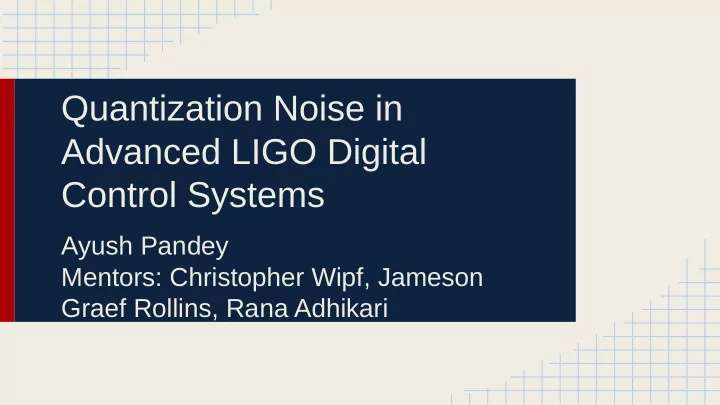

Quantization Noise in Advanced LIGO Digital Control Systems Ayush Pandey Mentors: Christopher Wipf, Jameson Graef Rollins, Rana Adhikari
Project Introduction ●Mixed Signal Systems ●Digital Control vs Analog Control ●Quantization Noise: One of the major demerits of Digital Control Systems ●Causes of Quantization Noise
Quantization Noise In Analog: 1.25 + 2.34500000199999 = 3.59500000199999 In double precision computer, (1.25) + (2.34500000199999) = 3.5950000012 Quantization Noise = (approximately) 10 -12 Similarly, two (B+1) bit numbers, on multiplication give a (2B+1) number which then needs to be truncated for a B+1 precision computer
Digital Control System : I Reference: National Instruments
Digital Control System : II
Improvements Possible ●To improve digital filter performance: ● Change filter structure ● Better the precision ● Error Feedback ●To improve DAC performance: ● Use higher precision DAC ● Noise Shaping ●For ADCs: ● Change Hardware Implementation and Design (Algorithm)
Quantization Noise Analysis of the Digital Controller
Background ●Filter Structure (Mathematical Operations, Order) ●State Space Representation of Digital Filters ●Low Noise Form (Matts Evans) ●Time Complexity and Performance ●For double precision implementation: (ref. Denis Martynov) ● Output(double)-Output(single) = Noise(single) ● Noise(double) = Extrapolation factor * Noise(single)
Improvements in Noise Estimation ●Precise Noise Estimation ●SNR Distribution and Warning System ●Code running time ●SNR Plot
Automatic Digital Controller Checker Tool A software tool based on MATLAB which performs the following: ●Searches for valid channel names (For sites, only recorded channels) ●Construct channel names from filter modules in Foton file archive (for all files) ●Download Data -> Perform Noise Estimation -> Plot ●Save the Data for future analysis...and repeat.
Testing on 40m Controller ●Caltech’s 40m prototype Interferometer Digital filters were Analyzed
LSC-POP110_I filter
For aLIGO sites ●Remote Access to input/output data for digital filters ●Only channels that are recorded ● Some output channel (only) recorded filters have been checked by inverting the filter ●Foton file archive checked out of SVN at ● Hanford: GPS Time: 1117896120 : Jun 9 14:41 UTC ● Livingston: GPS Time: 1117562416: Jun 5 18:00 UTC ●The complete set of resultant plots is available at : https://drive.google.com/folderview? id=0BzjRW8WwGjzJfkE3cVFzczJVU0JpSkZUTm1DR0dpWF9BWFlNVTh3VGg3UG93d HRLTURPZWs&usp=sharing
Observations and Inferences ●General Behaviour --Digital Filter Noise is way below Output spectrum level.
10 25 10 20 SNR 10 15 10 10 10 5 10 -1 10 0 10 1 10 2 frequency Hz SNR:H1:SUS-TMSY-M1-DAMP-Y-IN1-DQ
Filters with High Phase Lag (Higher Order filters) --SNR level lower
DF2 performs equally well as LNF --Gain like filters/filters not performing many calculations
DF2 above output spectrum --When Input signal is of very low order + High Phase Lag filter (Combined Effect)
Other Observations and Inferences ●Dependence and Independence on Input --Inference: More on the independent side. To an approximation. ●Generally, LNF is better than DF2 by an order of 100 -10,000 SNR
Filter Inversion 10 0 amplitude arb/sqrt(Hz) 10 -5 10 -10 10 -15 10 -1 10 0 10 1 10 2 10 3 frequency, Hz H1:LSC-REFL-SERVO-SLOW-OUT-DQ output data noise bqf
10 30 10 25 10 20 SNR 10 15 10 10 10 5 10 -1 10 0 10 1 10 2 10 3 frequency Hz SNR:H1:LSC-REFL-SERVO-SLOW-OUT-DQ
Limitations and Conclusions ●A major limitation : ● History of filters: The case when a filter is an integral type or higher order integrals ● Remedy: Proper Sample time for the filter ●Only recorded channels tested, but there could be problems within the controller ●Major conclusion: LNF filter performs great for most filters (>90%). Even for the other 10%, SNR > 10 2 -10 3 ●Not all filters can be inverted (from Output to Input) for analysis
DAC Quantization Noise
Ways to mitigate DAC Noise ●Using higher precision DACs ● But, there are hardware limitations ● Also, processing speed ●DAC architecture improvements ●DAC Noise Shaping ● Low noise in a particular band of frequencies at the cost of higher overall noise level.
DAC Noise Measurement
DAC Noise Shaping
Background : Noise Shaping ● On simple block diagram analysis, X’(z) = X(z) + E(z) (-1 + H_shaper(z)) where, X’(z) is output transfer function in z-domain and similarly, X(z) is input, E(z) is quantization error and H_shaper(z) is feedback transfer function ● Since, the noise needs to be fed back after a delay, the above equation is modified to be like: X’(z) = X(z) + E(z) (-1 + z -1 H_target(z)) where the delay is accounted for in the code. ● Essentially, noise is now “shaped” or modified according to our own choice.
Customized Noise Shaping for aLIGO DAC ●The robustness of the noise shaping algorithm. ●Suppress any peak (notch) in Quantization noise ●Or, suppress a particular band of frequencies all together. With a compensation elsewhere.
Hz
Simulations in MATLAB ●Algorithm implemented in MATLAB gave successful results for any arbitrary noise shape. ●For a high pass shaped noise (which is desirable for GW detection): Plot : Next Slide
Implementation in C To enable the frontend code to take advantage of the noise shaping algorithm developed. ●Filtering done using SOS coefficients ●No plotting in this case, hence error debugging with respect to MATLAB simulation results ●Noise shaped data given to the DAC
Project Conclusions and Scope ❖ There are two major conclusions of the project work and the research done in this project: ➢ For most of the filters analyzed, the low noise form performed better than DF2 and also SNR for most of them was acceptable. ■That being said, an exclusive testing of the controller still remains to be done as signals inside the controller were not tested.
Project Conclusions and Scope DAC Quantization Noise A primary concern due to its higher level has been mitigated to a great extent, according to the noise shaping algorithm proposed. The future scope would be to completely implement it in the system and take advantage of it.
Q & A Thank You!
Recommend
More recommend